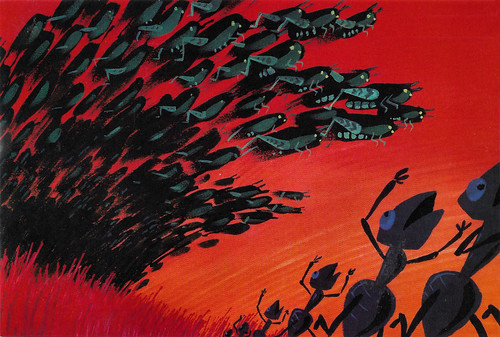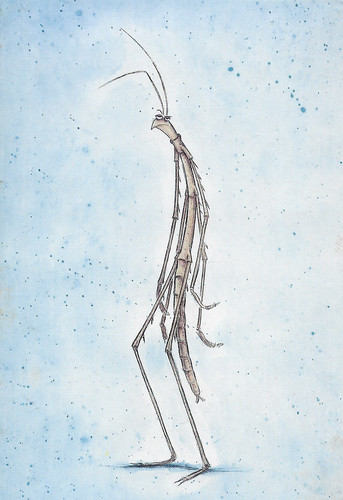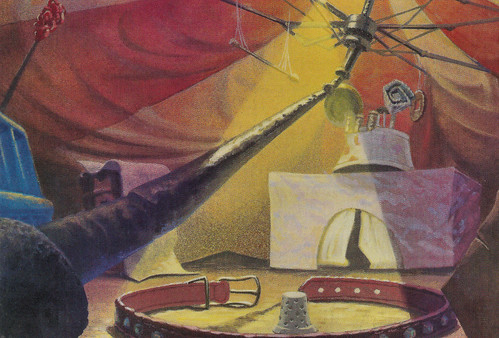
French postcard by Sonis, no. C. 941. Image: Disney / Pixar. Film image for A Bug's Life (John Lasseter, 1998). Sent by mail in 1999.

American postcard by Disney Enterprises / Pixar Animation Studios, 2005. Image: Pixar Animation Studios. Film image of A Bug's Life (John Lasseter, 1998). From 'The Art of Pixar: 100 Collectible Postcards', published by Chronicle Books.

American postcard by Disney Enterprises / Pixar Animation Studios, 2005. Image: Pixar Animation Studios. Film image of A Bug's Life (John Lasseter, 1998). From 'The Art of Pixar: 100 Collectible Postcards', published by Chronicle Books.
An ant colony suppressed by locusts
An ant colony on an island is suppressed by a group of locusts, led by Hopper. Each year, they claim a part of the food supply.
One of the ants is Flip, an outsider who prefers to work alone and is constantly trying to come up with new inventions. He is seen as an eccentric. On the day the locusts come again, Flip causes all the food he has collected to literally fall into the water.
The locusts think that, because of the lack of food, the ants are trying to revolt. Hopper demands that the ants deliver a double supply of food before the end of autumn. Then he and his gang leave. While Flip is on trial for what he has done, he suggests going to town to find larger insects that can drive the locusts away. The ant council agrees as they would like to get rid of Flip.
Flip reaches the insect city, a metropolis built of old boxes and other rubbish. In the same city, there is a circus. The artists of this circus are fired by their boss, P.T. Vlo, after a performance degenerated into chaos. Flip finds the fired insects and thinks they are the warriors he needs. The Bugs, in turn, think that Flip wants to hire them for their act.
He takes them to the colony. On the island, the performers soon make themselves popular when they rescue the young ant Dot from a bird. The attack gives Flip the idea of chasing off the grasshoppers with a fake bird. On his instructions, the ants build this bird.

Spanish postcard by Ediciones Beascoa S.A., Barcelona, no. P 136. Image: Disney / Pixar. Film image of A Bug's Life (John Lasseter, 1998).

American postcard by Disney Enterprises / Pixar Animation Studios, 2005. Image: Pixar Animation Studios. Concept art by Tia Kratter for A Bug's Life (John Lasseter, 1998). From 'The Art of Pixar: 100 Collectible Postcards', published by Chronicle Books.

American postcard by Disney Enterprises / Pixar Animation Studios, 2005. Image: Pixar Animation Studios. Concept art by Mark Holmes for A Bug's Life (John Lasseter, 1998). From 'The Art of Pixar: 100 Collectible Postcards', published by Chronicle Books.
A public feud
A Bug's Life was initially inspired by Aesop's fable 'The Ant and the Grasshopper'. The storyline originated from a lunchtime conversation between John Lasseter, Andrew Stanton, Pete Docter, and Joe Ranft, the studio's head story team. Other films such as Monsters, Inc., Finding Nemo, and WALL-E were also conceived at this lunch.
Lasseter and his story team had already been drawn to the idea of insects serving as characters. Like toys, insects were within the reach of computer animation back then, due to their relatively simple surfaces. Production began shortly after the release of Toy Story (1995). The screenplay was penned by Stanton and comedy writers Donald McEnery and Bob Shaw from a story by Lasseter, Stanton, and Ranft.
The ants in the film were redesigned to be more appealing, and Pixar's animation unit employed technical innovations in computer animation. Randy Newman composed the music for the film. During the production of A Bug's Life, a public feud erupted between DreamWorks' Jeffrey Katzenberg, and Pixar's Steve Jobs and John Lasseter.
Katzenberg, former chairman of Disney's film division, had left the company in a bitter feud with CEO Michael Eisner. In response, he formed DreamWorks SKG with Steven Spielberg and David Geffen and planned to rival Disney in animation. After DreamWorks' acquisition of Pacific Data Images (PDI) — long Pixar's contemporary in computer animation — Lasseter and others at Pixar were dismayed to learn from the trade papers that PDI's first project at DreamWorks would be another ant film, to be called Antz.
By this time, Pixar's project was well known within the animation community. Both Antz and A Bug's Life center on a young male ant, a drone with oddball tendencies that struggles to win a princess's hand by saving their society. Whereas A Bug's Life relied chiefly on visual gags, Antz was more verbal and revolved more around satire. The script of Antz was also heavy with adult references, whereas Pixar's film was more accessible to children.
It was clear that Lasseter and Jobs believed that the idea was stolen by Katzenberg. Katzenberg had stayed in touch with Lasseter after the acrimonious Disney split, often calling to check up. In October 1995, when Katzenberg asked what they were doing next, Lasseter described what would become A Bug's Life in detail. When the trades indicated production on Antz, Lasseter, feeling betrayed, called Katzenberg and asked him bluntly if it were true, who in turn asked him where he had heard the rumor. Lasseter asked again, and Katzenberg admitted it was true. Lasseter raised his voice and would not believe Katzenberg's story that a development director had pitched him the idea long ago. Katzenberg claimed Antz came from a 1991 story pitch by Tim Johnson that was related to Katzenberg in October 1994.
Lasseter grimly relayed the news to Pixar employees but kept morale high. Katzenberg moved the opening of Antz from spring 1999 to October 1998 to compete with Pixar's release. The film grossed $363.3 million worldwide, surpassing DreamWorks' Antz. Despite the successful box office performance of both Antz and A Bug's Life, tensions would remain high between Jobs and Katzenberg for many years.

British postcard by Boomerang Media. Image: Disney / Pixar. Film image of A Bug's Life (John Lasseter, 1998). Caption: Collect A Bug's Life character stampers with Robinsons. Start collecting tokens on special bottles and cartons of Robinsons now.

American postcard by Disney Enterprises / Pixar Animation Studios, 2005. Image: Pixar Animation Studios. Concept art by Geefwee Boedoe for A Bug's Life (John Lasseter, 1998). From 'The Art of Pixar: 100 Collectible Postcards', published by Chronicle Books.

American postcard by Disney Enterprises / Pixar Animation Studios, 2005. Image: Pixar Animation Studios. Concept art by Tia Kratter and Bob Pauley for A Bug's Life (John Lasseter, 1998). From 'The Art of Pixar: 100 Collectible Postcards', published by Chronicle Books.
Enormous promise for a new kind of storytelling
A Bug's Life won in 1999 the Academy Award for Best Music and received positive reviews. Todd McCarthy of Variety wrote: "Lasseter and Pixar broke new technical and aesthetic ground in the animation field with Toy Story, and here they surpass it in both scope and complexity of movement while telling a story that overlaps Antz in numerous ways."
Roger Ebert of the Chicago Sun-Times gave the film three and a half stars out of four, saying "I enjoyed too the use of animation to visualize a world that could not be seen in live-action and could not be created with special effects. Animation contains enormous promise for a new kind of storytelling, freed from reality and gravity, but although the Japanese have exploited that freedom, too many American feature cartoons follow the Disney formula of plucky young heroes and heroines and comic sidekicks.
It's a formula that has produced wonderful movies. But the Pixar computer animation studio, a Disney co-producer, broke new ground with Toy Story in 1995, and now with A Bug's Life, it runs free. The story, about an ant colony that frees itself from slavery to grasshoppers, is similar in some ways to the autumn's other big animated release, Antz, but it's aimed at a broader audience and lacks the in-jokes."
And at AllMovie, Matthew Doberman wrote: "A Bug's Life is a high point in animated family fare. It's the kind of film adults enjoy as much as, if not more than, their preschool offspring. Even the fake "outtakes" following the film are hilarious: like much of the film's humor, they aim for a surprising level of sophistication. The creators use animation not just to put a child-friendly face on some normally creepy critters, but to go where live-action can't, creating a world of shapes, colors, and sounds that couldn't be accomplished otherwise."

French postcard by Chromovogue, Boissy, no. 901263. Image: Disney / Pixar. Film image of A Bug's Life (John Lasseter, 1998).

American postcard by Disney Enterprises / Pixar Animation Studios, 2005. Image: Pixar Animation Studios. Concept art by Tia Kratter for A Bug's Life (John Lasseter, 1998). From 'The Art of Pixar: 100 Collectible Postcards', published by Chronicle Books.

American postcard by Disney Enterprises / Pixar Animation Studios, 2005. Image: Pixar Animation Studios. Concept art by Jason Katz for A Bug's Life (John Lasseter, 1998). From 'The Art of Pixar: 100 Collectible Postcards', published by Chronicle Books.

American postcard by Disney Enterprises / Pixar Animation Studios, 2005. Image: Pixar Animation Studios. Concept art by Nat McLaughlin, Bill Cane, and Tia Kratter for A Bug's Life (John Lasseter, 1998). From 'The Art of Pixar: 100 Collectible Postcards', published by Chronicle Books.

American postcard by Disney Enterprises / Pixar Animation Studios, 2005. Image: Pixar Animation Studios. Concept art by Tia Kratter and Nat McLaughlin for A Bug's Life (John Lasseter, 1998). From 'The Art of Pixar: 100 Collectible Postcards', published by Chronicle Books.
Sources: Roger Ebert (RogerEbert.com), Matthew Doberman (AllMovie), Wikipedia (Dutch and English), and IMDb.
No comments:
Post a Comment